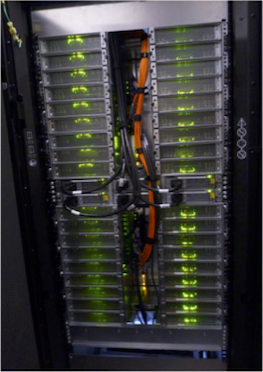CRAL has a dedicated infrastructure for intensive computing, the Common Computing Facility, financed by LabEx LIO.
Following the shutdown of the CCF-1 computing cluster in 2021 (see below), CRAL decided to pool its infrastructure for parallel computing within the PSMN mesocenter from the ENS de Lyon. These calculation resources, still financed by Labex LIO, are integrated into the Cascade cluster. These are 48 Cascade Lake compute nodes. Each node has 2 Intel Xeon Platinium 9242 processors with 48 cores and 384 GB of RAM. This partition therefore offers 4608 computing cores to CRAL researchers, engineers and students. These computing nodes are interconnected by a 100 Gb/s infiniteband network. CRAL also funded servers to provide dedicated storage space on the infiniband network. Finally, several “project” storage spaces were financed by projects using ANR or ERC type funding.
Link to documentation PSM
CCF-1
Previously CRAL made use of a 1200 core cluster, also named the Common Computing Facility, which was funded by the LIO LabEx. This cluster was managed by the Science Computing department of CRAL.
In 2014, the LIO acquired a super-computer with outstanding performance for massively parallel computing: the Common Computing Facility (CCF). It is the company SGI that won the tender launched by the LIO, proposing a solution whose characteristics are as follows: 1152 cores for a computing power of 24 Tflops and a total distributed memory of 9 TB. In more detail, the CCF, an SGI ICE X, consists of:
- 72 compute nodes, each with 2 Intel Xeon E5-2650v2 processors @ 2.6 GHz (8 cores) and 128 GB of RAM
- 1 storage node of 300 TB disk space
- 3 service nodes (login, administration)
- 1 visualization node
- All these nodes are interconnected by an infiniband network of FDR type.

The CCF was installed in 2 racks in the computing room at IPNL. The CCF was commissioned in autumn 2014, providing researchers and engineers with approximately 10 million computing hours per year.
In 2017, an extension of the CCF was installed. This extension was funded under the ERC advanced Grant TOFU supported by Isabelle Baraffe and put into service for the exclusive use of the researchers associated with this ERC. This extension consists of 4 new compute nodes, each with 2 Intel Xeon E5-2698 v4 processors @ 2.2 GHz (20 cores) and 128 GB of RAM.







